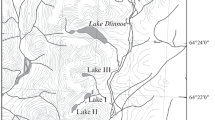Abstract
The submerged aquatic vascular vegetation was studied in the Finger Lakes and in two bays of Lake Ontario in northern New York State, U.S.A. The species composition, structure and biomass of the communities are related to the principal habitat factors such as trophic status of the lakes, bottom slope and substrate, current and stream effects, and depth. A record of the development of changes in the trophic status of the lakes and in the species composition of their submerged vascular vegetation is outlined. An attempt is made to assess the effects of catastrophic events (floods and cloudbursts in the watershed) on the lake vegetation.
Similar content being viewed by others
Literature Cited
Bannister, T. T. (1974): A general theory of steady-state phytoplankton growth in a nutrient saturated mixed layer.—Limnol. Oceanogr., Lawrence, Kansas, 19: 13–40.
Baston, L. Jr. etRoss, B. (1975): The distribution of aquatic weeds in the Finger Lakes of New York State and recommendations for their control.—New York State Assembly Public Service Legislative Study Program, SS-506, Albany New York.
Clausen, R. T. (1939): Aquatic vegetation of the Lake Ontario watershed.—In: A biological survey of the Lake Ontario Watershed.—New York State Dept. Conserv. Suppl. Annual Report No. 29; 167–187, Albany, New York.
Forest, H. S. etMills, E. L. (1971): The aquatic flora of Conesus Lake.—Proc. Rochester Acad. Sci., Rochester, New York, 12: 110–138.
Greerson, P. E. etRobinson, F. L. (1970): Characteristics of New York lakes. Part 1—Gazetteer of lakes, ponds, and reservoirs.—U. S. Dept. Interior—Geol. Survey Bull., Albany, New York, No. 68.
Josselyn, M. N. (1972): A taxonomic and ecological study ofMyriophyllum spicatum at the northern end of Cayuga Lake.—Senior Honors Thesis. (Dept. Bot. Cornell Univ., Ithaca, New York.)
Marcus, B. A. (1975): A simple and inexpensive technique for determining colored light intensity under water.—Water Resour. Res., Washington, D. C., 2: 491–492.
New York State Conservation Department (1927–1940): Supplements to Annual Reports, 16–29.—Albany, New York.
Peltier, W. H. etWelch, E. B. (1968): Factors affecting growth of rooted aquatic plants.— Report Tennessee Valley Authority, Chattanooga, Tenn. (Mimeographed)
Peverly, J. H., Oglesby, R. T., Vogel, A. etJohnson, R. (1974): Aquatic weed management in the Finger Lakes.—Techn. Report No. 90, Cornell Univ. Water Resour. Marine Sci. Center, Ithaca, New York.
Rickett, W. H. (1922): A quantitative study of the larger aquatic plants of Lake Mendota, Wisconsin.—Trans. Wisconsin Acad. Sci. Arts, Letters, Madison, Wisconsin, 20: 501–527.
Soulthorpe, C. D. (1967): The biology of aquatic vascular plants.—New York.
Westlake, D. F. (1965): Some basic data for investigations of the productivity of aquatic macrophytes. —In:Goldman, C. R. (ed.): Primary Productivity in Aquatic Environments.— Mem. 1st Ital. Idrobiol., 18 Suppl.: 229–248, Berkeley, California.
Author information
Authors and Affiliations
Rights and permissions
About this article
Cite this article
Forest, H.S. Study of submerged aquatic vascular plants in Northern Glacial Lakes (New York State, U.S.A.). Folia Geobot. Phytotax. 12, 329–341 (1977). https://doi.org/10.1007/BF02890647
Received:
Issue Date:
DOI: https://doi.org/10.1007/BF02890647




